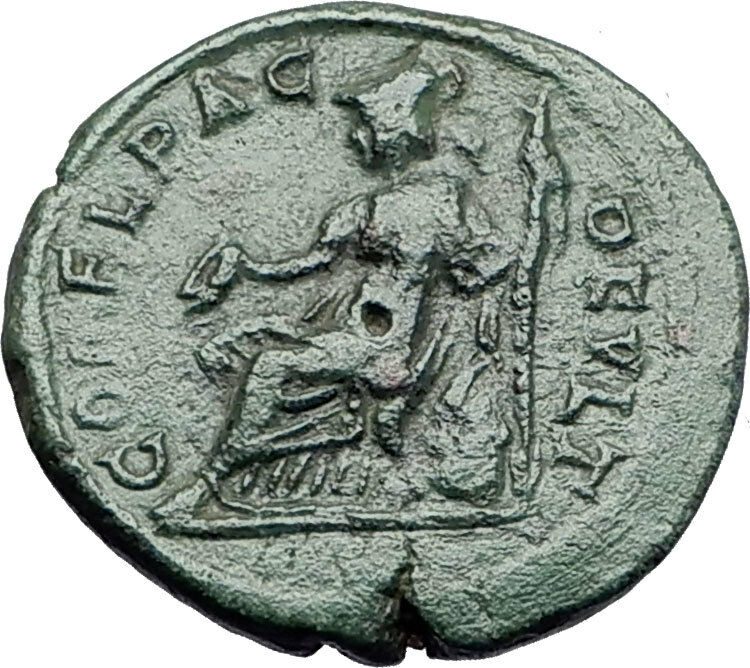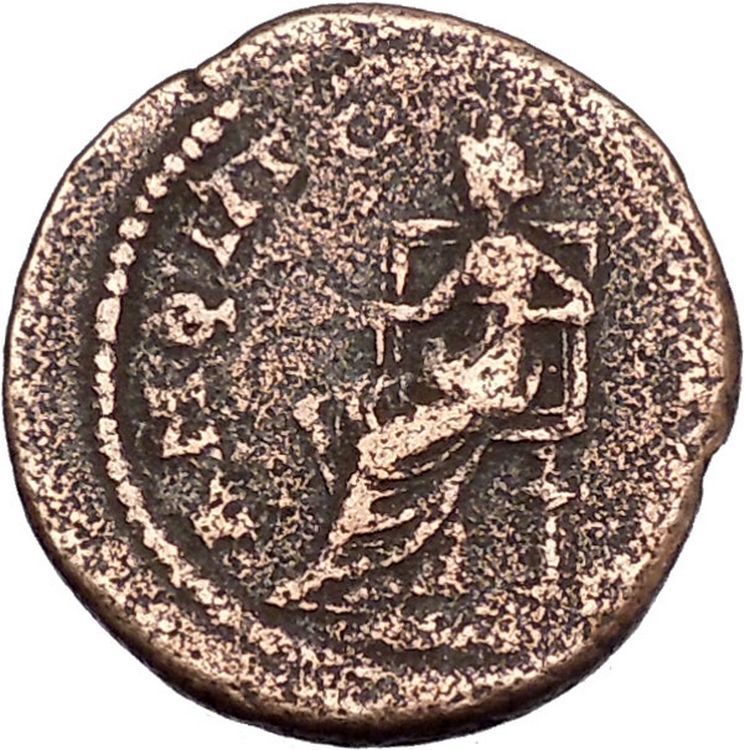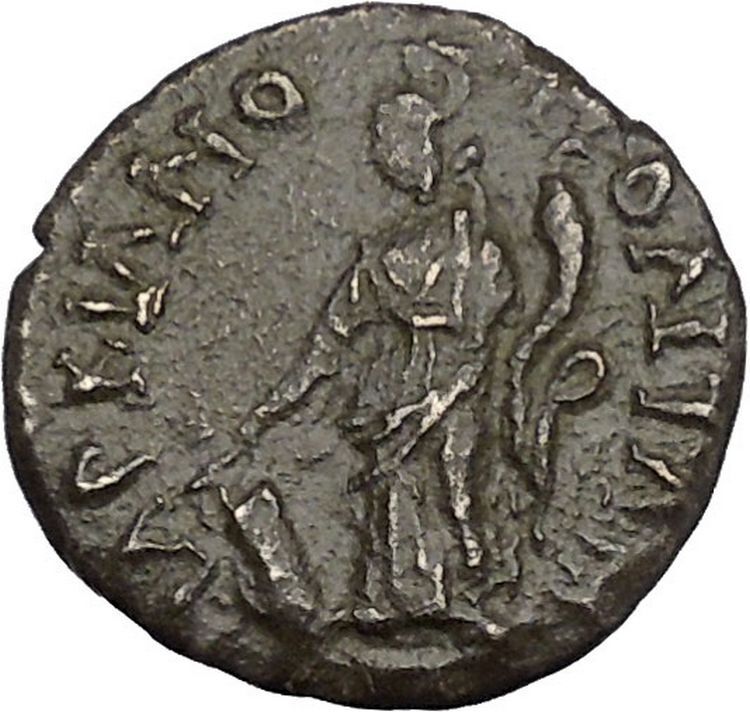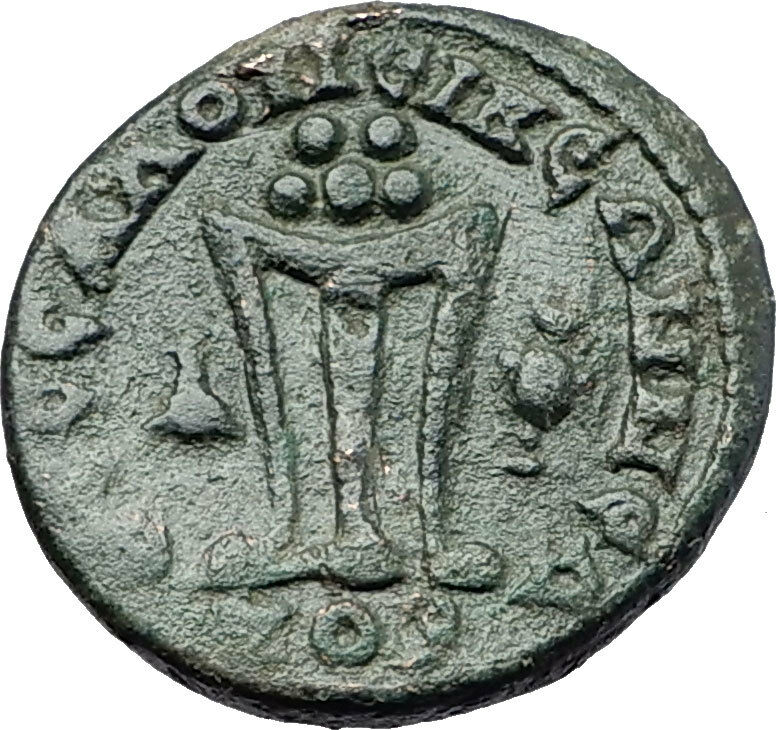|
Valerius Gratus, Procurator of Judaea, ruling 15-26 A.D.
under Tiberius – Roman Emperor: 14-37 A.D.
Bronze Prutah 15mm (1.72 grams) Jerusalem mint, dated year 3 of Tiberius’ reign, struck 16/17 A.D.
Reference: Hendin 1335
IOY ΛΙA (= Julia, Livia’s name) within wreath.
ΛΓ (year 3=16/17 A.D.) flank three lilies in bloom.
* Numismatic Note: This coin with the name Julia is in honor of the mother of Tiberius, Livia, whom was the wife of first Roman emperor Augustus. Tiberius was the adopted son of Augustus, being the son of Livia from her first marriage as Augustus and Livia never had children together.
The lily, or shoshan in Hebrew, was considered by the Hebrews as a very special flower. It’s ability to bloom rapidly linked it to associations with fertility. The lily flower was used as an ornamental flower in the Jerusalem Temple. It was the lily, along with 200 pomegranates that graced the capitals of the two main pillars, Boaz and Yachin at the entrance of the Temple. The lily was a symbol of Jerusalem itself.
Roman Procurator coinage were coins issued by the Roman Procurators and Prefects of the province of Judaea between 6 – 66 A.D. They minted only one denomination and size, the bronze prutah. Not all of the Procurators issued coinage. The procurators / prefects of the province of Judaea under the Romans that issued coins were Coponius, Marcus Ambibulus, Valerius Gratus, Pontius Pilate, Antonius Felix and Porcius Festus. The last three Procurators Lucceius Albinus, Gessius Florus and Marcus Antonius Julianus didn’t issue any coins as the tidings of the First Jewish-Roman War was in the air brewing during emperor Nero’s reign and the leaders of the revolt started issuing their own coins, for what is known as the Jewish War.
You are bidding on the exact item pictured, provided with a Certificate of Authenticity and Lifetime Guarantee of Authenticity.

Prutah (Hebrew: פרוטה) is a word borrowed from the Mishnah and the Talmud, in which it means “a coin of smaller value”. The word was probably derived originally from an Aramaic word with the same meaning.
The prutah was an ancient copper Jewish coin with low value. A loaf of bread in ancient times was worth about 10 prutot (plural of prutah). One prutah was also worth two lepta (singular lepton), which was the smallest denomination minted by the Hasmonean and Herodian Dynasty kings.
Prutot were also minted by the Roman Procurators of the Province of Judea, and later were minted by the Jews during the First Jewish Revolt (sometimes called ‘Masada coins’).
Valerius Gratus was the Roman Prefect of Iudaea province under Tiberius from 15 to 26 AD. He succeeded Annius Rufus and was replaced by Pontius Pilate.
The government of Gratus is chiefly remarkable for the frequent changes he made in the appointment of the high-priesthood. He deposed Ananus, and substituted Ismael, son of Fabi, then Eleazar, son of Arianus, then Simon, son of Camith, and lastly Joseph Caiaphas, the son-in-law of Ananus.
In popular culture
In the book Ben-Hur: A Tale of the Christ and its derived films, Gratus is almost killed by a tile which is accidentally dropped by Judah Ben-Hur, which prompts all subsequent events of the story. In the novel Gratus is portrayed as a corrupt governor who acted against the Jews by removing the rightful head priest of the Temple, Hannas, and replacing him with a Roman puppet, Ishmael.
Judea (Hebrew: יהודה, Standard Yehuda Tiberian Yehûḏāh; Arabic: يهودا; Greek: Ἰουδαία; Latin: IVDAEA), sometimes spelled in its original Latin forms of Judæa, Judaea or Iudaea to distinguish it from the geographical region of Judea, was a Roman province that incorporated the geographical regions of Judea, Samaria, and Idumea, and which extended over parts of the former regions of the Hasmonean and Herodian kingdoms of Israel. It was named after Herod Archelaus’s Tetrarchy of Judea, of which it was an expansion, the latter name deriving from the Kingdom of Judah of the 6th century BCE.
Rome’s involvement in the area dated from 63 BCE, following the end of the Third Mithridatic War, when Rome made Syria a province. In that year, after the defeat of Mithridates VI of Pontus, the proconsul Pompeius Magnus (Pompey the Great) sacked Jerusalem and entered the Jerusalem Temple. Subsequently, during the 1st century BCE, the Herodian Kingdom was established as a Roman client kingdom and then in 6 CE parts became a province of the Roman Empire.
Judea province was the scene of unrest at its founding during the Census of Quirinius and several wars were fought in its history, known as the Jewish-Roman wars. The Temple was destroyed in 70 as part of the Great Jewish Revolt resulting in the institution of the Fiscus Judaicus, and after Bar Kokhba’s revolt (132-135 CE), the Roman Emperor Hadrian changed the name of the province to Syria Palaestina and Jerusalem to Aelia Capitolina, which certain scholars conclude was done in an attempt to remove the relationship of the Jewish people to the region.
 Livia Drusilla, (Classical Latin: LIVIA•DRVSILLA, LIVIA•AVGVSTA) (58 BC-AD 29), after her formal adoption into the Julian family in AD 14 also known as Julia Augusta, was a Roman empress as the third wife of the Emperor Augustus and his advisor. She was the mother of the Emperor Tiberius, paternal grandmother of the Emperor Claudius, paternal great-grandmother of the Emperor Caligula, and maternal great-great grandmother of the Emperor Nero. She was deified by Claudius who acknowledged her title of Augusta. Livia Drusilla, (Classical Latin: LIVIA•DRVSILLA, LIVIA•AVGVSTA) (58 BC-AD 29), after her formal adoption into the Julian family in AD 14 also known as Julia Augusta, was a Roman empress as the third wife of the Emperor Augustus and his advisor. She was the mother of the Emperor Tiberius, paternal grandmother of the Emperor Claudius, paternal great-grandmother of the Emperor Caligula, and maternal great-great grandmother of the Emperor Nero. She was deified by Claudius who acknowledged her title of Augusta.
Tiberius – Roman Emperor: 14-37 A.D.
| Son of Livia | Step-son, son-in-law and heir of Augustus | Husband of Vipsania Agrippina and Julia | Brother of Nero Claudius Drusus | Father of Drusus (by Vipsania Agrippina) | Son-in-law of Agrippa | Father-in-law of Livilla | Grandfather of Livia Julia, and (possibly) of Tiberius Gemellus and Germanicus Gemellus | Uncle and Adoptive father of Germanicus, Claudius and Livilla | Adoptive grandfather of Nero Caesar, Drusus Caesar, Caligula, Agrippina Junior, Drusilla and Julia Livilla |
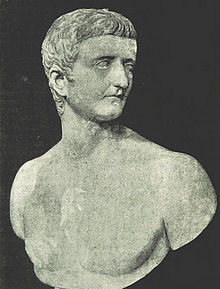 Tiberius Julius Caesar Augustus, born Tiberius Claudius Nero (November 16, 42 BC – March 16, AD 37), was the second Roman Emperor, from the death of Augustus in AD 14 until his own death in 37. Tiberius was by birth a Claudian, son of Tiberius Claudius Nero and Livia Drusilla. His mother divorced his father and was remarried to Octavian Augustus in 39 BC, making him a step-son of Octavian. Tiberius would later marry Augustus’ daughter Julia the Elder (from an earlier marriage) and even later be adopted by Augustus, by which act he officially became a Julian, bearing the name Tiberius Julius Caesar. The subsequent emperors after Tiberius would continue this blended dynasty of both families for the next forty years; historians have named it the Julio-Claudian dynasty. Tiberius Julius Caesar Augustus, born Tiberius Claudius Nero (November 16, 42 BC – March 16, AD 37), was the second Roman Emperor, from the death of Augustus in AD 14 until his own death in 37. Tiberius was by birth a Claudian, son of Tiberius Claudius Nero and Livia Drusilla. His mother divorced his father and was remarried to Octavian Augustus in 39 BC, making him a step-son of Octavian. Tiberius would later marry Augustus’ daughter Julia the Elder (from an earlier marriage) and even later be adopted by Augustus, by which act he officially became a Julian, bearing the name Tiberius Julius Caesar. The subsequent emperors after Tiberius would continue this blended dynasty of both families for the next forty years; historians have named it the Julio-Claudian dynasty.
Tiberius was one of Rome’s greatest generals, whose campaigns in Pannonia, Illyricum, Rhaetia and Germania laid the foundations for the northern frontier. But he came to be remembered as a dark, reclusive, and somber ruler who never really desired to be emperor; Pliny the Elder called him tristissimus hominum, “the gloomiest of men.” After the death of Tiberius son Drusus Julius Caesar in 23, the quality of his rule declined and ended in a terror. In 26, Tiberius exiled himself from Rome and left administration largely in the hands of his unscrupulous Praetorian Prefects Lucius Aelius Sejanus and Quintus Naevius Sutorius Macro. Caligula, Tiberius’ adopted grandson, succeeded the Emperor upon his death.
|






 Livia Drusilla, (Classical Latin: LIVIA•DRVSILLA, LIVIA•AVGVSTA) (58 BC-AD 29), after her formal adoption into the Julian family in AD 14 also known as Julia Augusta, was a Roman empress as the third wife of the Emperor Augustus and his advisor. She was the mother of the Emperor Tiberius, paternal grandmother of the Emperor Claudius, paternal great-grandmother of the Emperor Caligula, and maternal great-great grandmother of the Emperor Nero. She was deified by Claudius who acknowledged her title of Augusta.
Livia Drusilla, (Classical Latin: LIVIA•DRVSILLA, LIVIA•AVGVSTA) (58 BC-AD 29), after her formal adoption into the Julian family in AD 14 also known as Julia Augusta, was a Roman empress as the third wife of the Emperor Augustus and his advisor. She was the mother of the Emperor Tiberius, paternal grandmother of the Emperor Claudius, paternal great-grandmother of the Emperor Caligula, and maternal great-great grandmother of the Emperor Nero. She was deified by Claudius who acknowledged her title of Augusta. Tiberius Julius Caesar Augustus, born Tiberius Claudius Nero (November 16, 42 BC – March 16, AD 37), was the second Roman Emperor, from the death of Augustus in AD 14 until his own death in 37. Tiberius was by birth a Claudian, son of Tiberius Claudius Nero and Livia Drusilla. His mother divorced his father and was remarried to Octavian Augustus in 39 BC, making him a step-son of Octavian. Tiberius would later marry Augustus’ daughter Julia the Elder (from an earlier marriage) and even later be adopted by Augustus, by which act he officially became a Julian, bearing the name Tiberius Julius Caesar. The subsequent emperors after Tiberius would continue this blended dynasty of both families for the next forty years; historians have named it the Julio-Claudian dynasty.
Tiberius Julius Caesar Augustus, born Tiberius Claudius Nero (November 16, 42 BC – March 16, AD 37), was the second Roman Emperor, from the death of Augustus in AD 14 until his own death in 37. Tiberius was by birth a Claudian, son of Tiberius Claudius Nero and Livia Drusilla. His mother divorced his father and was remarried to Octavian Augustus in 39 BC, making him a step-son of Octavian. Tiberius would later marry Augustus’ daughter Julia the Elder (from an earlier marriage) and even later be adopted by Augustus, by which act he officially became a Julian, bearing the name Tiberius Julius Caesar. The subsequent emperors after Tiberius would continue this blended dynasty of both families for the next forty years; historians have named it the Julio-Claudian dynasty.

